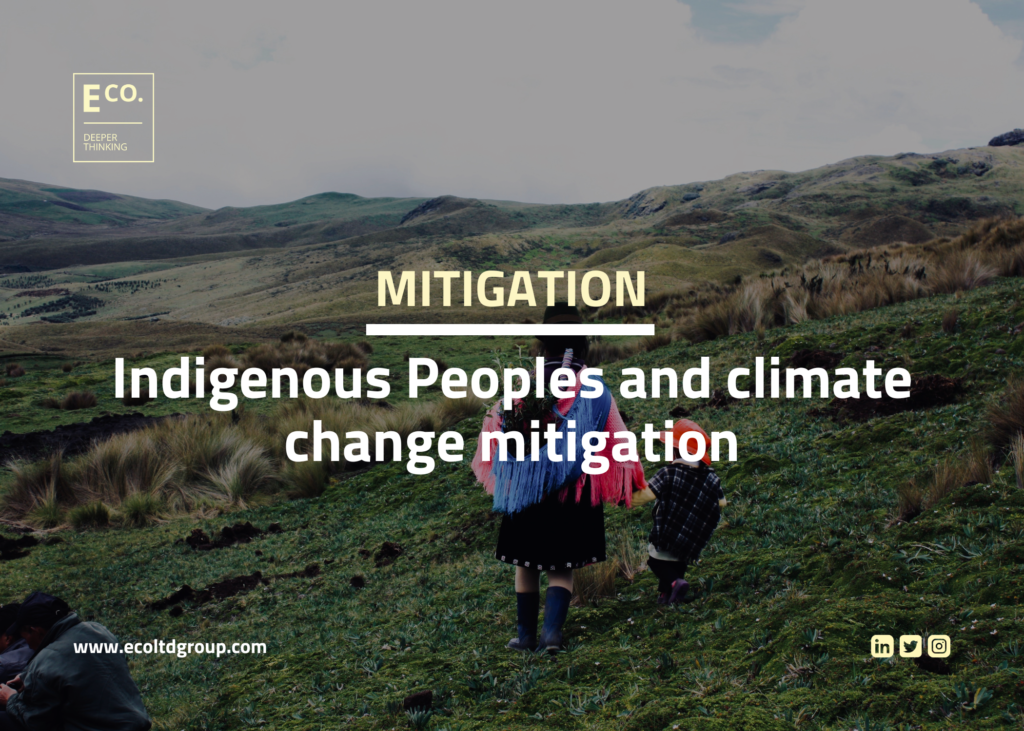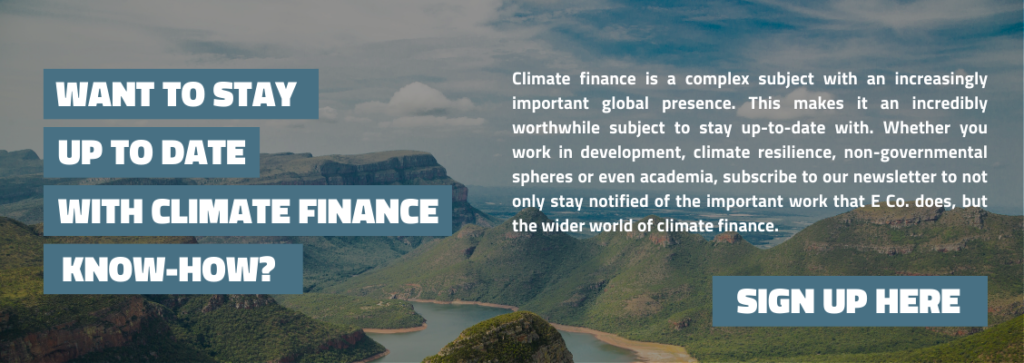Indigenous Peoples and climate change mitigation
9 August 2023, Category: All insights, News, Tags: climate change, climate finance, indigenous peoples, mitigation

By Mikael Ferreira
How can Indigenous Peoples find inclusion within mitigation strategies?
The impact of climate change falls unevenly on our shoulders. Although indigenous and impoverished communities did not set the fire of environmental degradation and biodiversity loss, they are now on the front lines, facing the sharpest blows of its consequences. The Intergovernmental Panel on Climate Change (IPCC) warns that the world must limit the increase in global average temperature to 1.5°C above pre-industrial levels to avoid disastrous consequences. This urgency highlights the need for effective mitigation measures to combat climate change.
Indigenous Peoples have always played an essential role in environmental conservation. Despite representing only 5% of the world’s population, indigenous territories are home to 80% of global terrestrial biodiversity. The World Resources Institute (WRI) has highlighted that in areas of the Amazon under indigenous management, deforestation rates are lower than in other lands. This data underlines the importance of Indigenous Peoples as vital actors in mitigating climate change and preserving the health of our planet.
In this article we will answer some questions on Indigenous Peoples and mitigation strategies:
- What roles do indigenous territories play in global biodiversity and environmental conservation?
- How do indigenous practices contribute to carbon sequestration and the fight against climate change?
- How can Indigenous Peoples be integrated into broader climate change mitigation strategies?
The role of indigenous territory in environmental conservation
The way Indigenous Peoples interact with their lands is fundamental to conservation; many of their centuries-old practices and traditions promote harmonious coexistence with nature, ensuring the preservation of biodiversity. In addition, forests managed by Indigenous Peoples are highly effective in sequestering carbon. In a recent study, forests on indigenous lands in the Brazilian Amazon were found to have sequestered, between 2001 and 2021, around 340 million tonnes of carbon dioxide (CO2) from the atmosphere, equivalent to the UK’s annual fossil fuel emissions.
Indigenous Peoples are critical not only to biodiversity but also to the overall integrity of global ecosystems. In the Amazon, for example, deforestation rates in indigenous territories are significantly lower when compared to other areas. Indigenous Peoples play a crucial role in protecting biodiversity and maintaining the integrity of global ecosystems. This reality is particularly evident where indigenous territories exhibit considerably lower deforestation rates compared to other areas. According to a Mapbiomas survey, while these lands have suffered a loss of only 1% of their native vegetation over the past three decades, private areas have seen a 20.6% reduction. However, the preservation of these lands has come at a devastating cost. In 2021, Indigenous Peoples, especially the Yanomami – a group of approximately 35,000 people who reside in the Amazon – became the main victims of violent episodes arising from territorial conflicts.
Indigenous practices and carbon sequestration
Indigenous Peoples play a key role in protecting and managing natural resources. Yanomami leader Davi Kopenawa illustrates this deep connection with nature by sharing his people’s worldview. For the Yanomami, trees are seen as pillars supporting the sky. In their view, destroying the forest would result in the fall of the sky and the consequent end of humanity. This view demonstrates how essential ndigenous People have been to the preservation of nature. They perceive the environment not only as a source of resources but as an integral part of their cultural identity and livelihoods.
They regard nature as a living being and maintain a reciprocal relationship with it, realizing the need to protect it for future generations. Over the centuries, Indigenous Peoples have developed sophisticated natural resource management systems that are both adaptive and sustainable. For example, the indigenous practice of controlled burning, used by indigenous peoples of Australia, not only prevents more severe bushfires but also renews soil health and promotes biodiversity. In the Amazon, Indigenous Peoples use agroforestry systems, which combine trees and crops in the same area, promoting carbon sequestration and increasing the resilience of local ecosystems.
In short, Indigenous Peoples have shown that by respecting and working with nature, it is possible to conserve biodiversity, maintain ecosystem services, and mitigate the effects of climate change. Their contributions are invaluable, not only to the continued health of Brazilian ecosystems, but also the global fight against environmental degradation.
Suggestions to integrate Indigenous People in climate action strategies
There are several actions that can be taken to ensure the needs, rights, and experience of Indigenous Peoples are included within mitigation work:
- Recognizing and strengthening indigenous territorial rights: Ensuring that Indigenous Peoples have clear and indisputable rights over their lands is critical. Studies show that areas under indigenous management experience lower rates of deforestation and are consequently more effective at sequestering carbon.
- Inclusion of Indigenous leaders in decision-making bodies: Integrating Indigenous leaders into committees, councils, and organisations addressing climate change ensures that their voices and perspectives are heard and considered.
- Direct funding of indigenous initiatives: Financially supporting projects developed and managed by indigenous communities can drive effective mitigation action at local and regional levels.
Keep up-to-date with climate finance know-how

Looking for insight into climate finance? Look no further
Get in touch with our climate finance consultants to discuss a project you’re working on and create successful, fit-for-purpose projects, now and in the future. Email us at: amy@ecoltdgroup.com or find us at the following:
Twitter: @ecoltdnews
LinkedIn: E Co.
Instagram: @ecoltdnews
References
Bardan, R. (2023, January 12). NASA Says 2022 Fifth Warmest Year on Record, Warming Trend Continues [Text]. NASA. http://www.nasa.gov/press-release/nasa-says-2022-fifth-warmest-year-on-record-warming-trend-continues
Castro, A. P. de, Fraxe, T. de J. P., Santiago, J. L., Matos, R. B., & Pinto, I. C. (2009). Os sistemas agroflorestais como alternativa de sustentabilidade em ecossistemas de várzea no Amazonas. Acta Amazonica, 39, 279–288. https://doi.org/10.1590/S0044-59672009000200006
IPCC. (2022). Global Warming of 1.5°C: IPCC Special Report on Impacts of Global Warming of 1.5°C above Pre-industrial Levels in Context of Strengthening Response to Climate Change, Sustainable Development, and Efforts to Eradicate Poverty (1st ed.). Cambridge University Press. https://doi.org/10.1017/9781009157940
Kettle, W. (2023, April 19). A importância dos povos indígenas para a preservação da natureza. Museu de Astronomia e Ciências Afins – MAST. https://www.gov.br/mast/pt-br/assuntos/noticias/2023/abril/a-importancia-dos-povos-indigenas-para-a-preservacao-da-natureza
Kopenawa, D., & Albert, B. (2015). A queda do céu: palavras de um xamã yanomami. Companhia das Letras.
Núbia, J. (2022, May 14). Terra Indígena adota sistema agroflorestal para aumentar produção da castanha: ‘queremos nos libertar da pobreza’. G1. https://g1.globo.com/ro/rondonia/natureza/amazonia/noticia/2022/05/14/terra-indigena-adota-sistema-agroflorestal-para-aumentar-producao-da-castanha-queremos-nos-libertar-da-pobreza.ghtml
Pajolla, M. (2022, April 19). Devastação é 20 vezes menor em terras indígenas, mas seus habitantes pagam com a vida. Brasil de Fato. https://www.brasildefato.com.br/2022/04/19/devastacao-e-20-vezes-menor-em-terras-indigenas-mas-seus-habitantes-pagam-com-a-vida
Steve, C., Winterbottom, R., Springer, J., & Reytar, K. (2014). Securing Rights, Combating Climate Change: How Strengthening Community Forest Rights Mitigates Climate Change (p. 64). World Resources Institute.
TNC. (n.d.). Fighting fire with fire. The Nature Conservancy Australia. Retrieved 8 August 2023, from https://www.natureaustralia.org.au/what-we-do/our-priorities/climate-change/climate-change-stories/fighting-fire-with-fire/
Veit, P., Gibbs, D., & Reytar, K. (2023). Florestas em terras indígenas estão entre os últimos sumidouros de carbono da Amazônia. https://www.wribrasil.org.br/noticias/florestas-em-terras-indigenas-estao-entre-os-ultimos-sumidouros-de-carbono-da-amazonia
World Bank. (n.d.). Indigenous Peoples [Text/HTML]. World Bank. Retrieved 8 August 2023, from https://www.worldbank.org/en/topic/indigenouspeoples
One Reply
Join the conversation by posting a comment below. You can either use your social account, by clicking on the corresponding icons or simply fill in the form below. All comments are moderated.
[…] Read more here […]